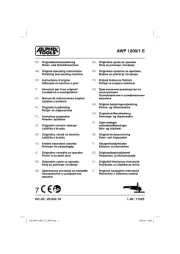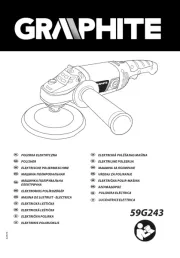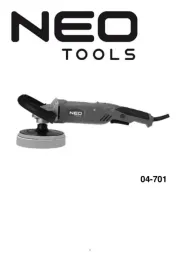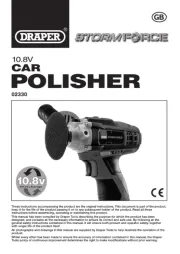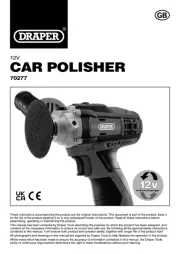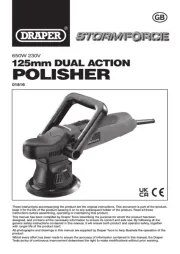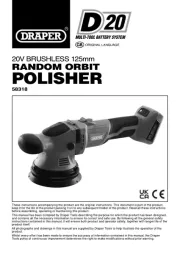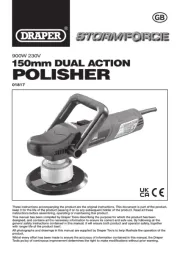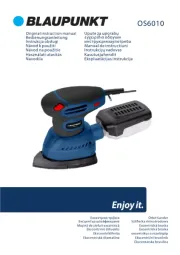INSTRUCTION MANUAL
GUIDE D'UTILISATION
MANUAL DE INSTRUCCIONES
DW845, DW847, DW849
Polishers
Polisseuses
Pulidoras
INSTRUCTIVO DE OPERACIÓN, CENTROS DE SERVICIO Y PÓLIZA
DE GARANTÍA. LÉASE ESTE INSTRUCTIVO ANTES ADVERTENCIA:
DE USAR EL PRODUCTO.
DEWALT Industrial Tool Co., 701 East Joppa Road, Baltimore, MD 21286
(APR07) Form No. 651827-00 DW845, DW847, DW849 Copyright © 2002, 2004, 2005, 2006, 2007 DEWALT
The following are trademarks for one or more D WALT power tools: the yellow and black E
colorscheme; the “D” shaped air intake grill; the array of pyramids on the handgrip; the kit box
configuration; and the array of lozenge-shaped humps on the surface of the tool.
If you have questions or comments, contact us.
Pour toute question ou tout commentaire, nous contacter.
Si tiene dudas o comentarios, contáctenos.
1-800-4-D WALT • www.dewalt.comE
Definitions: Safety Guidelines
The definitions below describe the level of severity for each signal word.
Please read the manual and pay attention to these symbols.
DANGER: Indicates an imminently hazardous situation which, if not
avoided, .will result in death or serious injury
WARNING: Indicates a potentially hazardous situation which, if not
avoided, could result in death or serious injury.
CAUTION: Indicates a potentially hazardous situation which, if not
avoided, may result in minor or moderate injury.
CAUTION: Used without the safety alert symbol indicates a potentially
hazardous situation which, if not avoided, result in may property
damage.
IF YOU HAVE ANY QUESTIONS OR COMMENTS ABOUT THIS OR ANY D WALT TOOL, E
CALL US TOLL FREE AT: 1-800-4-DEWALT (1-800-433-9258)
General Safety Rules – For All Tools
WARNING! Read and understand all instructions. Failure to follow all
instructions listed below may result in electric shock, fire and/or serious personal
injury.
SAVE THESE INSTRUCTIONS
WORK AREA
• Keep your work area clean and well lit. Cluttered benches and dark areas invite
accidents.
• Do not operate power tools in explosive atmospheres, such as in the presence of
flammable liquids, gases, or dust. Power tools create sparks which may ignite the dust or
fumes.
• Distractions Keep bystanders, children, and visitors away while operating a power tool.
can cause you to lose control.
ELECTRICAL SAFETY
• Grounded tools must be plugged into an outlet properly installed and grounded in
accordance with all codes and ordinances. Never remove the grounding prong or
modify the plug in any way. Do not use any adaptor plugs. Check with a qualified
electrician if you are in doubt as to whether the outlet is properly grounded. If the tools
should electrically malfunction or break down, grounding provides a low resistance path to
carry electricity away from the user. Applicable only to Class I (grounded) tools.
• Double insulated tools are equipped with a polarized plug (one blade is wider than the
other.) This plug will fit in a polarized outlet only one way. If the plug does not fit fully
in the outlet, reverse the plug. If it still does not fit, contact a qualified electrician to
install a polarized outlet. Do not change the plug in any way. Double insulation
eliminates the need for the three wire grounded power cord and grounded power supply
system. Applicable only to Class II (double insulated) tools.
• Avoid body contact with grounded surfaces such as pipes, radiators, ranges and
refrigerators. There is an increased risk of electric shock if your body is grounded.
• Don’t expose power tools to rain or wet conditions. Water entering a power tool will
increase the risk of electric shock.
• Do not abuse the cord. Never use the cord to carry the tools or pull the plug from an
outlet. Keep cord away from heat, oil, sharp edges or moving parts. Replace damaged
cords immediately. Damaged cords increase the risk of electric shock.
• When operating a power tool outside, use an outdoor extension cord marked “W-A”
or “W.” These cords are rated for outdoor use and reduce the risk of electric shock. When
using an extension cord, be sure to use one heavy enough to carry the current your product
will draw. An undersized cord will cause a drop in line voltage resulting in loss of power and
overheating. The following table shows the correct size to use depending on cord length and
nameplate ampere rating. If in doubt, use the next heavier gauge. The smaller the gauge
number, the heavier the cord.
Minimum Gauge for Cord Sets
Volts Total Length of Cord in Feet
120V 0-25 26-50 51-100 101-150
240V 0-50 51-100 101-200 201-300
Ampere Rating
More Not more AWG
Than Than
0 - 6 18 16 16 14
6 - 10 18 16 14 12
10 - 12 16 16 14 12
12 - 16 14 12 Not Recommended
PERSONAL SAFETY
• Stay alert, watch what you are doing and use common sense when operating a power
tool. Do not use tool while tired or under the influence of drugs, alcohol, or medication.
A moment of inattention while operating power tools may result in serious personal injury.
• Dress properly. Do not wear loose clothing or jewelry. Contain long hair. Keep your
hair, clothing, and gloves away from moving parts. Loose clothing, jewelry, or long
hair can be caught in moving parts. Air vents often cover moving parts and should also be
avoided.
• Avoid accidental starting. Be sure switch is off before plugging in. Carrying tools with
your finger on the switch or plugging in tools that have the switch on invites accidents.
• Remove adjusting keys or wrenches before turning the tool on. A wrench or a key that
is left attached to a rotating part of the tool may result in personal injury.
• Do not overreach. Keep proper footing and balance at all times. Proper footing and
balance enables better control of the tool in unexpected situations.
• Use safety equipment. Always wear eye protection. Dust mask, non-skid safety shoes,
hard hat, or hearing protection must be used for appropriate conditions.
TOOL USE AND CARE
• Use clamps or other practical way to secure and support the workpiece to a stable
platform. Holding the work by hand or against your body is unstable and may lead to loss of
control.
• Do not force tool. Use the correct tool for your application. The correct tool will do the
job better and safer at the rate for which it is designed.
• Do not use tool if switch does not turn it on or off. Any tool that cannot be controlled with
the switch is dangerous and must be repaired.
• Disconnect the plug from the power source before making any adjustments, changing
accessories, or storing the tool. Such preventative safety measures reduce the risk of
starting the tool accidentally.
• Store idle tools out of reach of children and other untrained persons. Tools are dangerous in the
hands of untrained users.
• Maintain tools with care. Keep cutting tools sharp and clean. Properly maintained tools,
with sharp cutting edges are less likely to bind and are easier to control.
• Check for misalignment or binding of moving parts, breakage of parts, and any other
condition that may affect the tool’s operation. If damaged, have the tool serviced
before using. Many accidents are caused by poorly maintained tools.
• Use only accessories that are recommended by the manufacturer for your model.
Accessories that may be suitable for one tool, may become hazardous when used on
another tool.
SERVICE
• Tool service must be performed only by qualified repair personnel. Service or
maintenance performed by unqualified personnel could result in a risk of injury.
• When servicing a tool, use only identical replacement parts. Follow instructions in
the Maintenance section of this manual. Use of unauthorized parts or failure to follow
maintenance instructions may create a risk of electric shock or injury.
Additional Specific Safety Instructions for Polishers
• Always use proper guard with grinding wheel. A guard protects operator from broken
wheel fragments and wheel contact.
• Hold tool by insulated gripping surfaces when performing an operation where the
cutting tool may contact hidden wiring or its own cord. Contact with a “live” wire will
make exposed metal parts of the tool “live” and shock the operator.
• Always use eye protection. All users and bystanders must wear eye protection that
conforms to ANSI Z87.1.
• Clean out your tool often, especially after heavy use. Dust and grit containing metal
particles often accumulate on interior surfaces and could create an electric shock hazard.
• Do not operate this tool for long periods of time. Vibration caused by the operating action
of this tool may cause permanent injury to fingers, hands, and arms. Use gloves to provide
extra cushion, take frequent rest periods, and limit daily time of use.
• Do not allow any loose portion of the polishing bonnet or its attachment strings to spin
freely. Tuck away or trim any loose attachment strings. Loose and spinning attachment
strings can entangle your fingers or snag on the workpiece.
Causes and Operator Prevention of Kickback
• Kickback is a sudden reaction to a pinched, bound or misaligned wheel, wire brush or
flap disc causing an uncontrolled cut-off tool to lift up and out of the workpiece toward the
operator.
• When the wheel is pinched or bound tightly by the workpiece, the wheel stalls and the motor
reaction drives the unit rapidly back toward or away from the operator.
• Kickback is the result of tool misuse and/or incorrect operating procedures or conditions and
can be avoided by taking proper precautions as given below:
• Maintain a firm grip with both hands on the unit and position your body and arm to
allow you to resist kickback forces. Kickback forces can be controlled by the operator,
if proper precautions are taken.
• When wheel is binding, or when interrupting a cut for any reason, release the trigger
and hold the unit motionless in the material until the wheel comes to a complete
stop. Never attempt to remove the unit from the work or pull the unit backward while
the wheel is in motion or kickback may occur. Investigate and take corrective actions
to eliminate the cause of wheel binding.
• When restarting a cut-off accessory in the workpiece, check that the wheel is not
engaged into the material. If wheel is binding, it may walk up or kickback from the
workpiece as the tool is restarted.
• Support large panels to minimize the risk of wheel pinching and kickback. Large
panels tend to sag under their own weight. Support must be placed under the panel on
both sides, near the line of cut and near the edge of the panel.
WARNING: ALWAYS use safety glasses. Everyday eyeglasses are NOT safety glasses.
Also use face or dust mask if cutting operation is dusty. ALWAYS WEAR CERTIFIED SAFETY
EQUIPMENT:
• ANSI Z87.1 eye protection (CAN/CSA Z94.3),
• ANSI S12.6 (S3.19) hearing protection,
• NIOSH/OSHA/MSHA respiratory protection.
WARNING: Always wear proper personal hearing protection that conforms to ANSI
S12.6 (S3.19) during use. Under some conditions and duration of use, noise from this product
may contribute to hearing loss.
WARNING: Some dust created by power sanding, sawing, grinding, drilling, and other
construction activities contains chemicals known to cause cancer, birth defects, or other
reproductive harm. Some examples of these chemicals are:
• lead from lead-based paints,
• crystalline silica from bricks and cement and other masonry products, and
• arsenic and chromium from chemically-treated lumber (CCA).
Your risk from these exposures varies, depending on how often you do this type of work.
To reduce your exposure to these chemicals: work in a well ventilated area, and work with
approved safety equipment, such as those dust masks that are specially designed to filter out
microscopic particles.
• Avoid prolonged contact with dust from power sanding, sawing, grinding, drilling, and
other construction activities. Wear protective clothing and wash exposed areas with
soap and water. Allowing dust to get into your mouth, eyes, or lay on the skin may promote
absorption of harmful chemicals.
WARNING: Use of this tool can generate and/or disburse dust, which may cause serious and
permanent respiratory or other injury. Always use NIOSH/OSHA approved respiratory protection
appropriate for the dust exposure. Direct particles away from face and body.
CAUTION: Use extra care when working into a corner because a sudden, sharp movement
of the grinder may be experienced when the wheel or other accessory contacts a secondary
surface or a surface edge.










